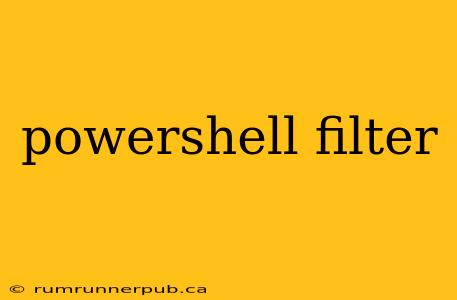PowerShell's filtering capabilities are a cornerstone of its power and flexibility. Whether you're sifting through log files, managing Active Directory, or automating system administration tasks, understanding how to effectively filter data is crucial. This article delves into various PowerShell filtering techniques, drawing upon insights from Stack Overflow and enriching them with practical examples and explanations.
Basic Filtering with Where-Object
The Where-Object cmdlet (often shortened to Where) is the workhorse of PowerShell filtering. It allows you to select objects based on specified conditions.
Example 1: Simple Filtering (inspired by Stack Overflow discussions on basic filtering)
Let's say you have a list of users and you want to find only those with "Admin" in their role.
$users = @(
@{Name = "Alice"; Role = "Admin"},
@{Name = "Bob"; Role = "User"},
@{Name = "Charlie"; Role = "Admin"}
)
$admins = $users | Where-Object {$_.Role -eq "Admin"}
$admins | Format-Table
This code first creates a list of users. Then, Where-Object filters this list, selecting only those objects where the Role property equals "Admin". The result is stored in the $admins variable and displayed using Format-Table.
Analysis: This demonstrates the basic syntax of Where-Object. The script block {$_.Role -eq "Admin"} is the crucial part. $_ represents the current object being processed, and the expression checks if its Role property is equal to "Admin".
Adding Value: We could easily extend this to filter by multiple criteria. For example, to find admins whose names start with "A":
$admins = $users | Where-Object {$_.Role -eq "Admin" -and $_.Name -like "A*"}
$admins | Format-Table
Advanced Filtering Techniques
Example 2: Using comparison operators (inspired by Stack Overflow questions on numerical comparisons)
Imagine you have a list of processes and you want to find those consuming more than 100MB of memory.
Get-Process | Where-Object {$_.WS -gt 100MB} | Select-Object ProcessName, WS
This snippet uses Get-Process to retrieve a list of running processes. Where-Object filters this list based on the WS (Working Set) property, selecting processes with a working set greater than 100MB. Select-Object then displays only the process name and working set.
Analysis: This showcases the use of comparison operators (-gt, -lt, -ge, -le, -eq, -ne) and the ability to use units directly within the comparison (100MB). This avoids the need for explicit conversion to bytes.
Adding Value: Error handling could improve robustness. For example, what if WS isn't available for a process? A more robust version might use a try-catch block to handle potential errors.
Example 3: Regular Expressions (common Stack Overflow theme related to text pattern matching)
Suppose you have a log file and you need to find lines containing specific error messages.
Get-Content log.txt | Where-Object {$_.Matches("Error:.*")}
Here, Get-Content reads the log file, and Where-Object filters lines containing "Error:" using a regular expression. .* matches any character (.) zero or more times (*).
Analysis: This demonstrates the power of regular expressions for pattern matching within PowerShell. You can use much more complex regular expressions to precisely filter based on text patterns.
Adding Value: Instead of just displaying matching lines, we could extract specific information from those lines using regular expression capture groups, providing more structured output for analysis.
Conclusion
PowerShell's filtering capabilities are extremely versatile. By mastering Where-Object and leveraging techniques like comparison operators and regular expressions, you can efficiently manage and process data in countless scenarios. Remember to consult Stack Overflow for solutions to specific challenges and to learn from the collective knowledge of the PowerShell community. Remember to always cite your sources appropriately when using code or information from Stack Overflow, which improves transparency and gives credit to the original contributors.
